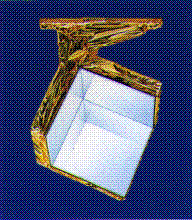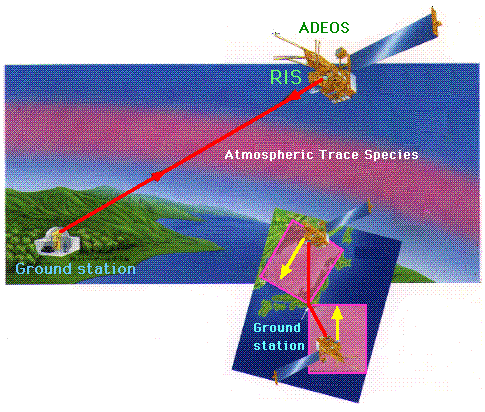RIS Retroreflector In Space
to Japanese Version
RIS
RIS (Retroreflector in Space) is a single element cube-corner retroreflector for earth-satellite-earth laser long-path absorption measurements of atmospheric trace species. RIS has a hollow structure with an effective diameter of 0.5m. A spherical mirror with a very small curvature is used for one of the three mirrors forming the corner cube, to optimize the ground pattern of the beam reflected by RIS on ADEOS, which moves with a velocity of approximately 7km/s.
In the RIS experiments a laser beam is transmitted form a ground station, reflected by RIS, and received back at the ground station. The absorption of the intervening atmosphere is measured in the round-trip optical path. The column contents and vertical profiles of atmospheric trace species are obtained from the measured spectra.
The RIS experiment is performed when ADEOS passes over one of the ground tracks within the regions shown in the figure. The satellite overpasses the measurement region approximately once daily on alternately ascending (nighttime) and descending (daytime) orbital paths. Measurements are taken on both ascending and descending paths and data collection lasts approximately 200 seconds each time.
The National Institute for Environmental Studies (NIES) and the Communications Research Laboratory (CRL) conduct experiments from the satellite tracking facility at CRL in Koganei-City, Tokyo. The ground system consists of an optical satellite tracking system and a laser transmitter and receiver system for spectroscopic measurements. An active satellite tracking method using the image of RIS lit by a second-harmonics Nd:YAG laser will be used simultaneously with the programmed tracking method, to achieve the tracking accuracy required for the experiments. Two single-longitudinal-mode TEA-CO2 lasers will be used for the spectroscopic measurements. Measurements of ozone, CFC12, HNO3, methane, CO, and other gases are planned with the ground station in Tokyo.

Structure of RIS

Observing technique of RIS
and Position of ADEOS when the RIS experiment is performed in TOKYO
Beside the experiment planned by NIES and CRL, experiments on atmospheric measurements and on laser ranging technology will be performed using RIS from independent ground stations.
RIS on ADEOS
Ground system and measurement
Data reduction and data distribution
Detailed information
RIS Science Team News
National Institute for Environmental Studies Home Page



